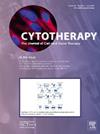Neural stem cell–derived extracellular vesicles purified by monolith chromatography retain stimulatory effect in in vitro scratch assay
IF 3.7
3区 医学
Q2 BIOTECHNOLOGY & APPLIED MICROBIOLOGY
引用次数: 0
Abstract
Background aims
Extracellular vesicles (EVs) have gained traction as potential cell-free therapeutic candidates. Development of purification methods that are scalable and robust is a major focus of EV research. Yet there is still little in the literature that evaluates purification methods against potency of the EV product. In the present study, we examined two monolith chromatography methods with a focus on assessing the ability of purified EVs to retain stimulatory effects on fibroblasts to connect scalable purification methods with product outputs.
Methods
We characterized EVs recovered from CTX0E03 (CTX) neural stem cell–conditioned medium in terms of biomarker distribution, functional capacity and purity. We evaluated the ability of EVs to promote wound closure in an in vitro scratch assay prior to and following two monolith chromatography steps (anion exchange and hydrophobic interaction) to determine whether these options may better serve EV bioprocessing.
Results
EVs from CTX cells were successful in initiating wound repair in a fibroblast scratch assay over 72 h with a single 20-μg dose. EV preparations presented the markers CD9, CD81 and CD63 but also contained culture albumin and DNA as process impurities. EVs recovered by tangential flow filtration could be successfully purified further by both monolith chromatography steps. Post-monolith EV stimulation was conserved.
Conclusions
The results indicate that monolith chromatography is a viable purification method for EVs derived from cell culture that does not detract from the product's ability to stimulate fibroblasts, suggesting that product functionality is conserved. Further work is needed in developing suitable downstream processes and analytics to achieve clinically relevant purities for injectable biologics.
单柱色谱纯化的神经干细胞来源的细胞外囊泡在体外划痕实验中保持刺激作用。
背景目的:细胞外囊泡(EVs)作为潜在的无细胞治疗候选者已经获得了关注。开发可扩展且稳健的净化方法是电动汽车研究的主要焦点。然而,在文献中仍然很少评估纯化方法对EV产品的效力。在本研究中,我们研究了两种单体色谱法,重点是评估纯化的ev对成纤维细胞保持刺激作用的能力,并将可扩展的纯化方法与产品产量联系起来。方法:对从CTX0E03 (CTX)神经干细胞条件培养基中提取的ev进行生物标志物分布、功能容量和纯度的表征。我们在两个单体色谱步骤(阴离子交换和疏水相互作用)之前和之后的体外划痕实验中评估了EV促进伤口愈合的能力,以确定这些选择是否可以更好地服务于EV的生物处理。结果:在成纤维细胞划伤实验中,来自CTX细胞的ev在单次20 μg剂量下,在72小时内成功启动伤口修复。EV制剂中含有CD9、CD81和CD63标记物,但也含有培养白蛋白和DNA作为工艺杂质。切向流过滤回收的电动汽车可以通过两个单柱色谱步骤进一步纯化。巨石后的EV刺激是保守的。结论:结果表明,对于来源于细胞培养的ev,单体色谱是一种可行的纯化方法,并且不会降低产品刺激成纤维细胞的能力,表明产品的功能是保守的。在开发合适的下游工艺和分析方面需要进一步的工作,以实现可注射生物制剂的临床相关纯度。
本文章由计算机程序翻译,如有差异,请以英文原文为准。
求助全文
约1分钟内获得全文
求助全文
来源期刊

Cytotherapy
医学-生物工程与应用微生物
CiteScore
6.30
自引率
4.40%
发文量
683
审稿时长
49 days
期刊介绍:
The journal brings readers the latest developments in the fast moving field of cellular therapy in man. This includes cell therapy for cancer, immune disorders, inherited diseases, tissue repair and regenerative medicine. The journal covers the science, translational development and treatment with variety of cell types including hematopoietic stem cells, immune cells (dendritic cells, NK, cells, T cells, antigen presenting cells) mesenchymal stromal cells, adipose cells, nerve, muscle, vascular and endothelial cells, and induced pluripotential stem cells. We also welcome manuscripts on subcellular derivatives such as exosomes. A specific focus is on translational research that brings cell therapy to the clinic. Cytotherapy publishes original papers, reviews, position papers editorials, commentaries and letters to the editor. We welcome "Protocols in Cytotherapy" bringing standard operating procedure for production specific cell types for clinical use within the reach of the readership.
 求助内容:
求助内容: 应助结果提醒方式:
应助结果提醒方式:


